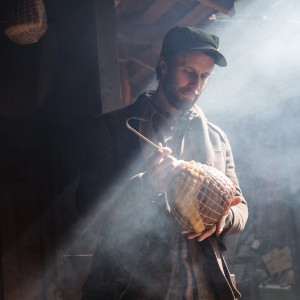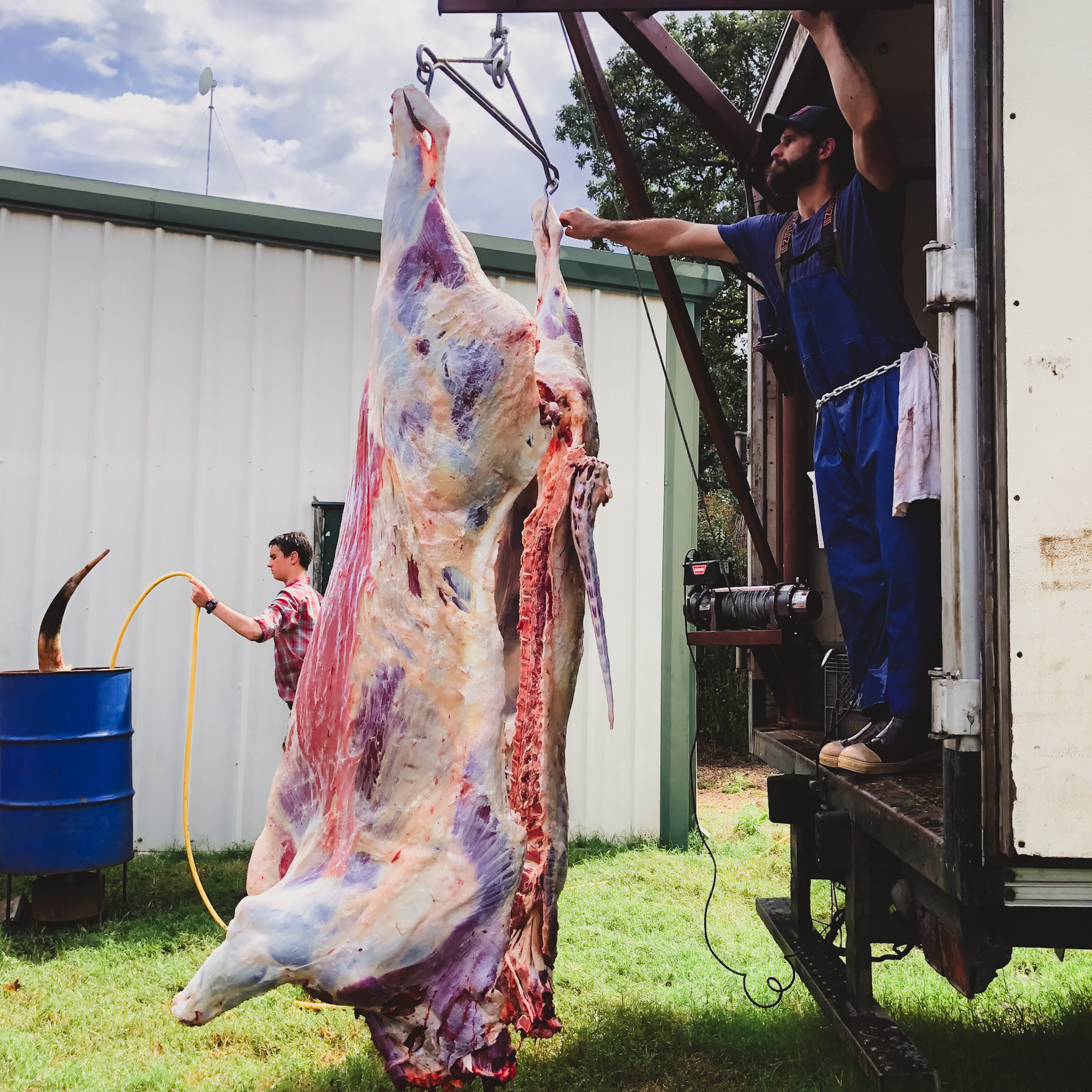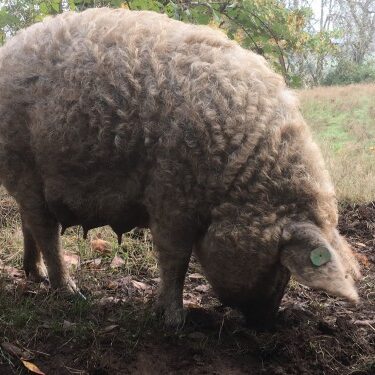Forested Gloucester Old Spot Pork Shares
(Sold out for October 2025)

The flavor of pork properly husbanded and expertly harvested beguiles analysis. This is not due to the complexity of the process, but to the purity of raising pigs on a human scale. These pigs were born, fed and harvested on our farm. They eat only organic grain from the prairie and what they harvest from the forest floor. These pigs have eaten as many acorns, hickory nuts and pecans as the trees supply.
I cannot put the flavor of mast-finished pork into words; it must be put in the mouth. The partnership of the pig and the forest is ancient for good reason. The flesh of pigs on pannage is preserved from embittering oxidation, and the fat is mild, soft and nutty. This is a difference in kind and not merely degree from grocery store fare.
Part of the recipe is economy, but I don’t employ the modern sense of the word. I mean benevolent ingenuity that respects the soil’s bounty and repose, where the language of waste is unintelligible, where the pigs feed the trees as much as the forest feeds the pigs. In other words, old-world ham.
In northern Spain, there are ancient hills of pasture and oak trees, like the cross timber of northeastern Oklahoma. For centuries, pigs have been grazing the Spanish dehesa . The sacrificio de cerdos or pig slaughter is the acorn harvest. The oak trees and grasses thrive without competition from understory brambles, cleared by the pigs, and the pigs are thanked with an annual gallimaufry of acorns. This relationship produces the best air dried ham in the world, the jamon de bellota.
In addition to the acorns, the pigs are fed fresh organic feed from Peterson Organic Feeds in Missouri. Field peas replace the ubiquitous soy in the ration to keep the fat transparent to the salubrious affect of the forest forage.
These shares are the next level of excellence in my pursuit of artful husbandry because, for the first time, I have an oak forest and breeding stock. From birth, all the way to freezer wrapping, I have the privilege of being the farmer, grower, slaughter man, butcher, and curer of these pigs. It is therefore my unique pleasure to offer pork thoroughly treated by artfulness worthy of the family table.

Distinctives of this Product
- Our package includes cold smoking all bacon, hams and hocks. The wood is a blend of oak and hickory from the same trees that feed the pigs.
- The Gloucestershire Old Spot breed: These are the cottage pigs of yore and I selected them for their unique ability to generously deposit sweet saturated fat, delicate unsaturated fat and make the most of forage. They are also the politest of all pig breeds.
- Management: Our goal is to raise these not at the expense of the soil, but to its benefit. They are given plenty of forest, shade and a clean wallow for cooling off in summer heat.
- Slaughter & Butchery: During slaughter, we retain the skin, head and trotters. As to butchery, you get 100% of your hanging weight. These kind of pigs find the notion of trim to be offensive.
- Curing: Rather than merely flavoring pork with nitrites, we employ detailed
knowledge of traditional curing processes. These require no weird sugars or non-food ingredients. Our hams, hocks and bacon are cured with sea salt and cool smoke. - We’re friends forever: 100% of the pork eating population unequivocally loves bacon, ham and sausage. The physiology of a side of pork results in a few more roasts, chops, and braises as well. Cutting a pig this way eliminates waste which makes it possible for us to fit an entire side into each share. Also, we want you to stay in touch with your questions so we can offer cookery guidance.
Includes
One share is 100% of one side of pork and will take the form of:
- roughly 10-20lbs linked sausage
- rendered leaf lard
- One belly of salt cured bacon – cured, smoked, sliced and wrapped for your freezer
- 2 brined & smoked hocks
- one large boneless smoked ham for simmering and roasting
- 8-10 chops
- 1 tenderloin
- 1 loin roast
- 3-4 shoulder roasts
- Spare ribs
- 1 roll of back fat
- half a head
- a cured jowl, or guanciale
When
- 4 shares available for mid-October 2025 pick up.
- We estimate hanging weight to be 140-250 lbs for each carcass (many factors make this a wide estimate), putting a share (1/2 pig) between 70-135 lbs. The cost is $13.50/pound for everything, including all the value-added items: no extra fees or increase cost for value-add products. This price includes all your sausage, bacon, hams and rendered lard.
How to Get One
- Email us to reserve a share: community@farmsteadmeatsmith.com
- Pay a $350 non-refundable deposit to confirm share. Pay a second $350 in late summer for final feed costs. (You can also pay $700 all at once).
- We’ll email you for pickup confirmation. Pickup will be in our shop outside Tulsa, Oklahoma. We do not ship.
- Pay the balance when you pickup your share.
Email us to reserve a share community@farmsteadmeatsmith.com
Longhorn Beef Shares
(Not currently offering)

It is an honor for me, after 15 years of butchery and husbandry, to finally offer beef shares. It took moving to the cross-timber prairie, where the abundant pasture and long season all but require any farmer to raise cows. More than anything, I relish the fittingness of matching perfect grass-fed beef with traditional harvesting methods. Too often, grass-fed steers are processed as if they were from a feedlot. They are slaughtered too young, minimally aged, and mostly ground. Consequently, grass-fed beef has a bad reputation for being chewy and dry.
Treating grass-fed beef with the art of traditional harvesting actualizes all its potency. Grass-fed beef is, in fact, more tender and more flavorful than prime feed-lot beef when properly harvested. Each share is, therefore, not subjected to excessive trimming but artfully carved to serve the pot, the pan, and the oven.
This means that each heifer or steer is not slaughtered until they are at least three years old. This is when the Texas Longhorn reaches its maturity, both in terms of physiology and flavor. Because the longhorn has survived for centuries in the fenceless range of our continent, its flesh is darker and richer, generationally adapted to what our prairies supply.
This meat must, therefore, be sufficiently aged before it is cooked. Each beef is hung for a minimum of thirty days before it is butchered. This process matures and ripens the meat, making even the heavy-use musculature, such as the round and chuck, tender and easy to cook.
Being grass-fed, the fat is not excessively oily or rancid, like feedlot beef, but rather sweet and nutty. Each share is, therefore, not subjected to excessive trimming but artfully carved to serve the pot, the pan, and the oven.

These longhorns are born and grown on 100 acres of cross-timber prairie. They are rotationally grazed, ensuring fresh grass every day of the year and providing substantial rest for the pasture. The Longhorns are never dewormed or fed grain, and they drink filtered well water fresh every day. There are no stagnant watering holes in their pasture.
This is the best beef I have ever tasted. It represents the unbroken harmony between traditional husbandry and traditional harvesting. I look forward to harvesting this beef for you next month.
-Brandon Sheard
When
- We are not currently offering these shares. Email Community@farmsteadmeatsmith.com for availability info or SUBSCRIBE to hear when we will offer shares again.
- Each share is approximately 100 lbs and is a crafted bundle of steaks, roasts, ground beef, and bones that reflects the entire yield of a Longhorn beef carcass.
- The cost is $13/lb.
How to Get One
- Email us to reserve a share at community@farmsteadmeatsmith.com.
- Pay a $650 non-refundable deposit to confirm share via Venmo or check.
- We’ll email you for pickup confirmation mid-July. Pickup will be at our shop outside Tulsa, Oklahoma. WE DO NOT SHIP OUR SHARES.
- Pay the balance when you pickup your share, approximately $650. Each share will be wrapped, labeled, and boxed for easy transport to your home.
Mangalitza Pork Shares
(Not currently offering)

I can’t deny the feeling that I have been building up to the Mangalitsa for the past eight years. For all of Meatsmith history, we have been exploring the heights and depths of our earliest axiom: pork fat is delicious and healthful.
Not all fat is created equal. Diet and genetics, through human coercion, have given pig fat a bad name. Generations of breeding for leanness and soy based rations have done one thing: made fat bitter and rancid. Hence, the thought of eating a slice of pork fat undiluted with lean meat is tongue curling.
There is a group of pig breeds that have evaded the degradation of industrial production, some of them on the verge of extinction. These are the lard pigs. The Mangalitsa is an Hungarian lard pig.
These pigs grow at half the speed of their leaner counterparts and produce at least twice the fat content at slaughter weight. Subjecting these pigs to standard butchery techniques of fat trimming would reduce the yield by at least half. But these pigs aren’t for chops and boneless loin roasts. The fat is the point.
Only traditional methods of cutting and curing rightly utilize all the fat. That is what these shares are for: a feast of salubrious pork fat, unreproved.
Similarly, rather than steel and concrete confinement or hog barns, lard pigs were raised on pannage, a method of forest, riparian and edge foraging once common in the ancient forests of Europe. Roots and nuts abound and these are the fat crafters, responsible for the best hams in the world. The pig killing was also called the acorn harvest.
Mangalitsas are genetically predisposed to this kind of husbandry. They produce fat on the oily side of the lipid spectrum. This unsaturated bias means that the diet and husbandry will be directly evident in the flavor, such that if these pigs eat something oily, like hazelnuts or acorns, you will taste hazelnut and acorn oil in the cured pork.

This places a strict responsibility on the farmer who must be certain that nothing undesirable, like oily fish or soy, will be fed to the transparent metabolisms of these particular pigs. Chris Gruver of Uneven Ground Farm has upheld this husbandry standard with uncommon commitment.
His pigs range on over one hundred acres of paddocks in Oregon. They forage on pasture, garry oak forests, and along streams. Chris supplements the acorns they find in the forests with hazelnuts from surrounding farms. In addition, they get a small ration of barley and peas which lends the necessary structure of saturated fat to the lipid profile. The tannins from the acorns, roots and bark they eat also play their antioxidant role in the fat, protecting its sweetness from the bitterness brought on by rancidity.
This is what the pigs have lived on for almost two years.
Most pigs are harvested at six months. These Mangalista grow for almost two years. This increased lifespan results in more marbling and more myoglobin in the muscle tissue so that the meat is red. I am honored to harvest Chris’s pigs and offer them to you. My goal is to let the pork do the talking by employing traditional methods. Rather than trim most the carcass and coerce the pork to fit complex recipes with synthetic ingredients, I choose the artistry of the Hungarian peasant who developed the Mangalitsa in the first place.
The peasant kitchen best embodies the marriage of thrift and extravagance. And it is to re-create this well-off frugality and to fulfill my destiny that I offer:
The Meatsmith Mangalitza Half Pig Share
Szalonna, cured back fat (similar to Italian lardo and Russian salo). This is a slab of fat to be sliced thinly and served raw on hot bread with olive oil, or sliced thick on rye bread with vodka, or cut into a chunk to be skewered and melted over a fire to drip lard onto bread with slices of cucumber and onion. Or use it like pancetta, cubed and rendered in a skillet as the oily medium for fried eggs, or braised greens. As with all salubrious pig fat, there are infinite uses. The only way to use it poorly is to use it infrequently. Wrapped for the freezer.
Coppa, cured neck with black pepper, smoked. Ready to hang in your kitchen for a few months of drying to be sliced thin and served raw with cheeses, pickles, crackers, or on a sandwich. You can also slice it right away and fry it like breakfast bacon. Coppa will hang indefinitely at room temperature, even after you start slicing into it. Like all traditional cures, it may grow beneficial mold.
Bacon, cured with juniper and smoked, sliced and wrapped for the freezer.
Sonka, boneless smoked ham for roasting, wrapped for the freezer. Cook the ham in a deep roasting pan at 350f. After about forty minutes, peel off the skin (reserve for stock) and apply a glaze of mustard and honey. Attentively wax the ham every ten to fifteen minutes with more until it is cooked to an internal temperature of 140f. Let it rest for 25 minutes before slicing. Whatever is left over will keep as cold-cut ham in the fridge for well over a week.
Smoked hocks. These are to be braised, ideally in a pot of dried beans with stock. Cook gently for two hours, or until the meat pulls easily from the bone. Wrapped for the freezer.
Kolbasz, sausage links for frying, wrapped for the freezer. Poach gently before frying for 4 minutes, and/or flip only once in the skillet to prevent rupture. Seasoned with sweet smoked paprika, a hint of heat, onions and pepper.
Back bacon, cured with juniper, smoked, sliced and wrapped for the freezer. This is bacon made from the loin (aka Canadian bacon); what is commonly turned into chops on leaner pigs. The loins of lard pigs find their best and highest use as bacon.
Back Fat for larding. This is frozen square slabs of fat. Subcutaneous pork fat, or back fat, is the most solid fat on the pig. It therefore lends itself to being thawed, then cut into long strips, clamped in a larding needle and sewn into a lean roast. This fat tastes of hazelnuts and the mild mineral sweetness of demerara sugar.
Guanciale, cured jowl. Like the coppa, this is also ready to hang in your kitchen, and to be sliced, chopped and set to melt in a low temperature skillet for frying, browning meat or cooking vegetables. Guanciale will hang indefinitely at room temperature, even after you start slicing into it. Like all traditional cures, it may grow beneficial mold.
Leaf Lard. This will be packaged in quart containers and stored at refrigerator temperature. It is however stable to sit on your counter at arms-length when needed. This is the original shortening. It does not have an intense porky flavor and is the best general purpose cooking oil in the cosmos. Substitute half the butter in a pie crust recipe with leaf lard and tie your shoes tight.
Larding needle. An essential but erstwhile neglected tool for the delicious and thrifty use of solid pork fat in the kitchen. Clamp a strip of back fat in the jaws and pass the whole needle through a beef roast like London broil, through chicken breast, venison back strap or leg of lamb. When the needle is removed on the other side it leaves a strip of fat inside the otherwise lean and dry meat, imparting juiciness and ineffable Mangalitsa sweetness.
Stock bones and one tenderloin comprise the fresh meat of the share. These will be frozen.
Email Community@farmsteadmeatsmith.com for availability info or SUBSCRIBE to hear when we offer shares again
When
- We are not currently offering these shares. Email Community@farmsteadmeatsmith.com for availability info or SUBSCRIBE to hear when we will offer shares again.
- We estimate hanging weight to be 175-350 lbs for each carcass (many factors make this a wide estimate), putting a share (1/2 pig) between 87.5-175 lbs. The cost is $13.75/# for everything, including all the value-added items: no added fees or product up-sales. This price includes all your cures, rendered lard, larding needle, etc.
How to Get One
- Email us to reserve a share: community@farmsteadmeatsmith.com
- Pay a $500 non-refundable deposit to confirm share.
- We’ll email you for pickup confirmation. (You must pick up the share, WE DO NOT SHIP).
- Pay the balance when you pickup your share.
